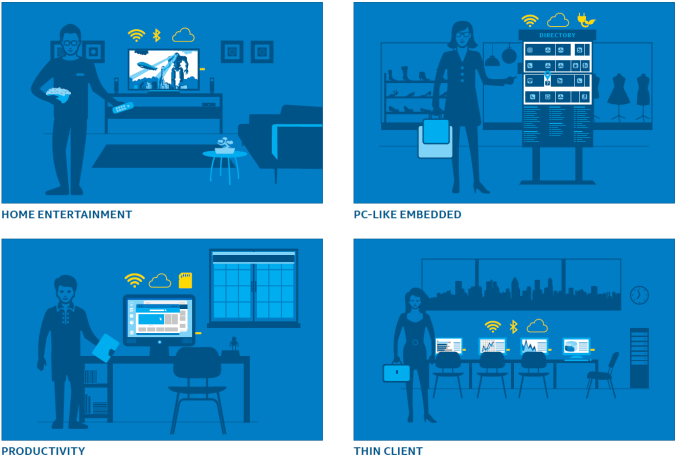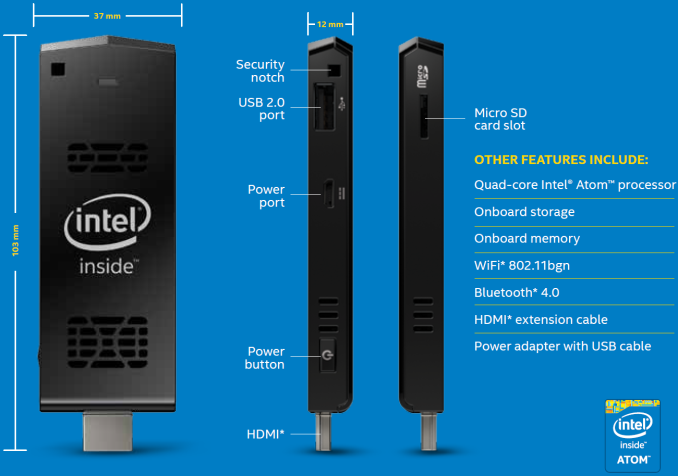Intel PPSTCK1A32WFC Bay Trail-T Compute Stick Review
by Ganesh T S on April 22, 2015 11:00 AM EST- Posted in
- Systems
- Intel
- Bay Trail
- HDMI Stick
Concluding Remarks
The Intel Compute Stick gave us the opportunity to see whether a tablet SoC could provide enough horsepower for a desktop PC. Based on our experience, the answer to that question is cautiously in the affirmative. There is no doubt that the device can do well as an economical solution for thin clients, kiosks and digital signage. These are scenarios where only one program runs for the life of the system and the OS is rarely updated.
The Compute Stick could do with some improvements for the scenarios in the left column
Traditional PCs have a different use-case compared to PC-like embedded systems and that brings us to the first problem in the Compute Stick we reviewed:
- OS drive size
32 GB, simply put, is just not enough after Windows installs a couple of updates. Out of the box, the system had around 17 GB free in the 23 GB disk (the rest, presumably, is the OS recovery partition). An initial update check resulted in a 1.3 GB download, and that installation brought down the free space to 14.3 GB. We have always been wary of Windows Updates on machines with low free space on the primary drive. As feared, attempting to install another round of updates resulted in a botched update problem (solved here). We had to spend 4+ hours getting the unit back to the initial state with a 'refresh' operation (and reinstall all the updates once again). To top it off, Windows lost activation in the refresh process and refused to reactivate (indicating a blacklisted key).
- Thermal design / solution
There is no doubt that the thermal design is very effective. Acoustic measurements come in at 28 dB at 1m distance. However, the irregular nature of the small-diameter fan makes for a strained experience if the user sits very close to the Compute Stick (possible in an office environment). It would not be a bad idea to go for a passively cooled Compute Stick at the cost of a slight increase in cost, weight and/or size.
- WLAN solution
The unit doesn't come with any wired networking facilities. It is essential that the Wi-Fi solution be top-notch. Unfortunately, a single-band 1x1 802.11n solution just doesn't cut it - particularly for scenarios involving video streaming. Thankfully, the presence of Bluetooth makes a USB keyboard / mouse unnecessary, freeing up the single USB 2.0 port for other purposes. Talking of video streaming, it would also be nice to have full HD audio support in the GPU drivers for Bay Trail-T (now that it has made its appearance in a mini-PC).
Despite the above shortcomings, the Compute Stick did impress us in a few areas - the form factor and portability aspects are praiseworthy. The CPU performance is not as bad as we feared it would be - Windows loads in a smooth manner and the system is as responsive as what one can expect from a Bay Trail-based mini-PC.
Coming to the business end of the review, we can say that the Intel Compute Stick is a typical first-generation product. In our opinion, there are way too many compromises being made to get to this form factor. There are certainly applications where the kit would be perfect, but general-purpose day-to-day computing is not one of them. If Intel wants the Compute Stick product line to take off like NUCs, addressing the three main shortcomings detailed above would be a good first step.












103 Comments
View All Comments
ToTTenTranz - Wednesday, April 22, 2015 - link
IMO, lack of Ethernet and terrible WiFi performance kills the product from the start.This is obviously intended to turn a TV into a media host device with the added functionality of running Windows, but if a very slow WiFi connection is the only way to get connected, then the product is rather useless.
With a decent WiFi AC receiver, this would be the ideal Steam Home Streaming client.
Krysto - Wednesday, April 22, 2015 - link
Slow and expensive for what it offers - I'd say that defines Intel pretty well these days.Krysto - Wednesday, April 22, 2015 - link
Oh and don't forget this is the kind of "Celerons" and "Pentiums" we're going to see from now on - for $100-$160 a chip.Drumsticks - Wednesday, April 22, 2015 - link
Not really sure why you're ignoring the $50 Celeron G1820 which is a 2.7Ghz Haswell chip, but hell if it makes you feel better go ahead.Drumsticks - Wednesday, April 22, 2015 - link
Edit: And if you're referring to mobile bay/cherry trail parts, it's not like consumers can personally buy those anyways.Refuge - Wednesday, April 22, 2015 - link
Thats right, because Microsoft lets Intel use Windows for FREE.Forgot that deal.
v1001 - Wednesday, April 22, 2015 - link
Wait a minute so every single one of these is going to crap out when people go to add the windows updates?? How is that acceptable? They can't seriously expect everyone who buys this to find a work around do they? Is Windows 10 smaller? Any luck there with upgrading to that in July? I want to buy a few of these for some TV's. But I'm not going to cut it that close on the updates, I mean what happens on the next windows update and that's it, you went over and can't do a single thing after that...Marc GP - Wednesday, April 22, 2015 - link
Looks like you'd be much better served with something like the HP Stream Mini.Uplink10 - Thursday, April 23, 2015 - link
Stop advertising HP Stream Mini, Zotac miniPC or Gygabite BRIX barebones are better and you can even put in youtr desired HDD and RAM and they only cost around 120$. See my post above.dtgoodwin - Wednesday, April 22, 2015 - link
I'm surprised that they had issues with updates. I'm running a Winbook 7" with only 1GB of ram and 16 GB on board storage. I've added a microSD 64-gig card, but windows updates will only stage/install on the c: partition. I've got less than 1 GB free, but all the updates have applied - I just got this two weeks ago, so I'd consider it a fairly comparable situation. I did run disk cleanup including system updates, but I never ran into an error. It is too bad that there's no way to extend the drive space of c: using a microSD, or to have Windows seamlessly use it for temp files, or be able to move other files to it. It would also greatly help if they allowed you to move the "recovery" partition to a USB stick and be able to recover by placing that back in the device. Recovering 5 GB of space would be really helpful. Of course, my tablet only cost $40.00. It also plays NetFlix and Youtube output to HDMI acceptably, and even my medium bitrate Blu-Ray rips.